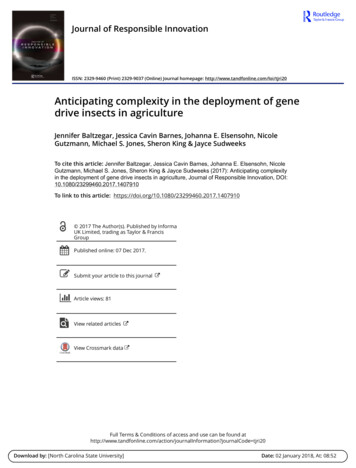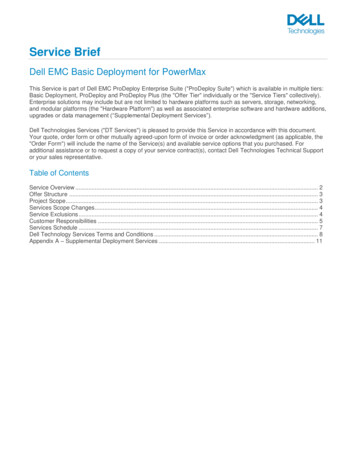
Transcription
Journal of Responsible InnovationISSN: 2329-9460 (Print) 2329-9037 (Online) Journal homepage: http://www.tandfonline.com/loi/tjri20Anticipating complexity in the deployment of genedrive insects in agricultureJennifer Baltzegar, Jessica Cavin Barnes, Johanna E. Elsensohn, NicoleGutzmann, Michael S. Jones, Sheron King & Jayce SudweeksTo cite this article: Jennifer Baltzegar, Jessica Cavin Barnes, Johanna E. Elsensohn, NicoleGutzmann, Michael S. Jones, Sheron King & Jayce Sudweeks (2017): Anticipating complexityin the deployment of gene drive insects in agriculture, Journal of Responsible Innovation, DOI:10.1080/23299460.2017.1407910To link to this article: https://doi.org/10.1080/23299460.2017.1407910 2017 The Author(s). Published by InformaUK Limited, trading as Taylor & FrancisGroupPublished online: 07 Dec 2017.Submit your article to this journalArticle views: 81View related articlesView Crossmark dataFull Terms & Conditions of access and use can be found tion?journalCode tjri20Download by: [North Carolina State University]Date: 02 January 2018, At: 08:52
JOURNAL OF RESPONSIBLE INNOVATION, ESEARCH ARTICLEAnticipating complexity in the deployment of gene driveinsects in agricultureJennifer BaltzegarNicole Gutzmanna*, Jessica Cavin Barnes b*, Johanna E. Elsensohn c*,*, Michael S. Jones d*, Sheron Kinge* and Jayce SudweekscDownloaded by [North Carolina State University] at 08:52 02 January 2018ae*bDepartment of Biological Sciences, North Carolina State University, Raleigh, NC, USA; Department ofForestry and Environmental Resources, North Carolina State University, Raleigh, NC, USA; cDepartment ofEntomology and Plant Pathology, North Carolina State University, Raleigh, NC, USA; dDepartment ofAgricultural and Resource Economics, North Carolina State University, Raleigh, NC, USA; eSchool of Public andInternational Affairs, North Carolina State University, Raleigh, NC, USAABSTRACTARTICLE HISTORYInsects cause substantial losses to agricultural crops each yearand require intensive management approaches. Genetic pestmanagement has emerged as a viable, non-chemical alternative formanaging insect pests. The development of engineered genedrives for agricultural use is promising, though unproven, and hasthe potential to impact farmers as well as broader socio-ecologicalsystems in several ways. Drawing on lessons from the deploymentof other pest control technologies, this paper considers howinsects containing gene drives could intersect with some of thecomplexities that characterize agricultural systems. Gene drives arebeing developed in a landscape of pest management shaped bypast and current approaches, experiences, regulations, publicopinion, and pest invasions. Because gene drive insects may spreadwell beyond their release area, stakeholder groups at differentspatial scales need to be engaged in decisions about theirdeployment. This new paradigm both complicates and offers greatpromise for future pest management efforts.Received 2 May 2016Accepted 26 October 2017KEYWORDSGenetic pest management;gene drives; complexity;agriculture; interdisciplinaryIntroductionSince the beginning of agriculture, societies have worked to protect crops from destructionby insect pests (Oerke 2006). Pest control strategies have tracked developments in bothtechnological innovation and knowledge of pest behavior, incorporating mechanical, cultural, chemical, and biological approaches over time. Today, agricultural insect pests inconventional systems are often controlled with synthetic chemicals, combined in somecases with transgenic, insecticidal plants. Although current strategies prevent substantiallosses, an estimated 30–40% of staple crops are still lost to the combined impact ofinsects and plant pathogens, many of which are insect-vectored (Oerke 2006). In additionto limited efficacy, pesticides are a suboptimal solution owing to their potential impacts onCONTACT Johanna E. Elsensohnjeelsens@ncsu.edu*All authors contributed equally to this work. 2017 The Author(s). Published by Informa UK Limited, trading as Taylor & Francis GroupThis is an Open Access article distributed under the terms of the Creative Commons Attribution-NonCommercial-NoDerivatives nd/4.0/), which permits non-commercial re-use, distribution, and reproduction in anymedium, provided the original work is properly cited, and is not altered, transformed, or built upon in any way.
Downloaded by [North Carolina State University] at 08:52 02 January 20182J. BALTZEGAR ET AL.beneficial organisms, the evolution of resistance in insect populations, their associationwith negative human health outcomes, and the economic burden placed on producersby the necessity of routine applications. Addressing some of these ecological and socialconcerns, genetic approaches to pest control have emerged as non-chemical alternativesfor managing insect populations. Informed by the principles of evolutionary biology,genetic pest management (GPM) harnesses the mechanisms of genetic inheritance insexually reproducing insect species to achieve either population suppression (the localelimination of a pest species or reduction in its population to below economically relevantlevels) or population replacement (the replacement of individuals in a population withnon-pestilent variants) (Curtis 1985; Robinson 1998). This paper considers how a potentially revolutionary technique for GPM – engineered gene drives – might fit into complexsocio-ecological landscapes that have been shaped by the political, economic, cultural, andenvironmental legacies of other pest management approaches.Although interest in agricultural GPM has expanded with recent and growing concernsover pesticide use, the potential for a genetic approach to insect control was first identifiedby Serebrovskii (1940), before the limitations of chemical control and the need for alternatives were fully realized (Robinson 1998). Since then, scientists have worked to develop anapproach to genetic control that would link desired traits, like sterility or vector incompetence, with ‘selfish’ genetic elements that bias inheritance, driving through populations atrates higher than expected by the laws of Mendelian genetics (Burt and Trivers 2006;Gould 2008). However, early attempts to appropriate naturally occurring selfish geneticelements have been limited by the difficulty of manipulating these complex systems inmany organisms, including model species (as reviewed in Champer, Buchman, andAkbari 2016). Progress in subsequent efforts to reengineer selfish elements has likewisebeen slowed by their lack of flexibility and stability (Esvelt et al. 2014; Gould 2008).Many of these limitations could potentially be addressed by a new technique for cuttingand modifying DNA based on a mechanism of adaptive immunity in bacteria, calledCRISPR1/Cas (Horvath and Barrangou 2010). Co-opted as a gene editing tool, CRISPR/Cas can be used to alter genes in individual organisms or to create a self-replicatinggene drive system that may remain active across many generations. In gene editing applications, the resulting molecular changes can be passed on to subsequent generations vianormal inheritance, but the CRISPR/Cas machinery is not. Alternatively, in gene driveapplications, genes coding for the CRISPR/Cas components necessary for gene editingare incorporated into the recipient organism’s genome. Theoretically, because CRISPR/Cas acts as a selfish genetic element, copying itself onto homologous chromosomes, all offspring inherit the gene editing machinery, allowing the process of gene editing to self-perpetuate and endure in subsequent generations (Esvelt et al. 2014). No CRISPR/Cas genedrive has been field-tested or deployed to date, and applied use of this techniqueremains hypothetical. However, laboratory proof-of-concept has been demonstrated foryeast (DiCarlo et al. 2015), fruit flies (Gantz and Bier 2015), and mosquitoes (Gantzet al. 2015; Hammond et al. 2015). These successes have inspired proposals to useCRISPR-based gene drives to combat insect-borne diseases, control invasive species,assist threatened species, and manage pest populations more specifically and sustainably(Esvelt et al. 2014).The pace of ‘the CRISPR revolution’ (Barrangou 2014) and application of this systemto gene drive research has raised both excitement and alarm. Discussion about gene
Downloaded by [North Carolina State University] at 08:52 02 January 2018JOURNAL OF RESPONSIBLE INNOVATION3drives has been brought to the forefront of public and academic platforms (e.g. Barrangou 2014; Montenegro 2016), and in 2016 the National Academy of Sciences, Engineering, and Medicine (NASEM) in the United States published a committee report on theresponsible conduct of laboratory research and field releases with gene drive organisms(NASEM 2016). Nearly a decade ago, Gould (2008) anticipated the emergence of robustengineered gene drive systems and identified the need for an interdisciplinary approachto determining the suitability of gene drives for controlling particular pests. He outlineda range of genetic, evolutionary, ecological, economic, and ethical questions to be considered before gene drives or other forms of genetic control are deployed. Although thenumber of peer-reviewed publications on gene drives has grown precipitously over thelast decade, integrated and in-depth consideration of many of the socio-cultural and political-economic dimensions of the technology remains limited. Some of these questionshave received particularly little attention as they apply to agricultural applications ofgene drives, partly because gene drive organisms developed to address human healthand conservation problems are closer to applied use (e.g. NASEM 2016).This paper considers some of Gould’s (2008) questions in the specific context of genedrive deployment for the control of insect pests in agriculture. We focus on the economicand socio-cultural concerns previously raised by Gould (2008) and discuss additionalunknowns that might emerge from the ways in which insect biology intersects with cultures, technologies, and environments in agricultural systems. Specifically, this paper considers the identification of relevant stakeholders; the distribution of costs and benefits;potential impacts on specialized agricultural producers; trade patterns and regulations;and the dynamics of public engagement and approval. Drawing on the history, science,and in some cases, controversy, of other biologically inspired technologies for thecontrol of pest populations, including genetically modified (GM) crops, releases ofsterile insects, and classical biological control, we anticipate and describe several complexities that might characterize the potential deployment of gene drives in agriculturalsystems.Can relevant stakeholders be identified and consulted?Gould (2008) indicated that a key ethical question to be considered prior to gene drivedeployment is whether truly informed consent can be obtained from groups that standto be positively or negatively impacted by the technology. This concern has beenechoed in more recent calls for the involvement of public audiences in decision-makingaround the applied use of gene drives (e.g. Esvelt et al. 2014; Montenegro 2016;NASEM 2016). However, for agricultural gene drive systems, the question remains howto draw boundaries around relevant stakeholders in both space and time. Insects containing gene drives (hereafter ‘gene drive insects’) constitute an area-wide pest control strategythat is most effective when applied over large geographic areas (Alphey et al. 2013). In contrast to control options like insecticides that are adopted on a farm-by-farm basis, areawide approaches have the potential to impact everyone within the release zone. Further,the molecular constructs in gene drive systems are designed to spread, and may movethroughout the target species’ geographic range. The unique nature of gene driveinsects necessitates both big-picture and long-term thinking in the identification andengagement of stakeholders.
Downloaded by [North Carolina State University] at 08:52 02 January 20184J. BALTZEGAR ET AL.The stepwise eradication of the New World screwworm fly (Cochliomyia hominivoraxCoquerel), an insect pest of cattle, from North and Central America, began in 1958 andpreceded the emergence of academic and activist attention to public engagement inscience. Genetic control in this case was achieved through the sterile insect technique(SIT), which involves the sterilization and release of a large number of flies that inundatethe native pest population, leading females to mate with sterile males and produce noviable offspring (Davidson 2012). Stakeholder involvement in this program consisted ofunidirectional public information campaigns, farmer and rancher education, and cooperative agreements between the governments of participating countries and internationalgoverning bodies (Klassen and Curtis 2005). While this program met little resistance,several controversies have emerged around more recent projects that have released GMorganisms into human-inhabited environments without adequate public engagement.For example, in 2010, Oxitec, Ltd. (now a subsidiary of Intrexon Corporation) collaborated with the Mosquito Research and Control Unit of the Cayman Islands to release3.3 million effectively sterile male Aedes aegypti mosquitoes on Grand Cayman. Theproject engendered considerable backlash due to a perceived lack of sufficient publicknowledge or regulatory oversight (Subbaraman 2011). The controversy surroundingthis case has led to increased public engagement in subsequent releases of GM mosquitoesby Oxitec, Ltd. in Brazil and Malaysia (Carvalho et al. 2015; Subramaniam et al. 2012).In some cases, the identification and inclusion of relevant stakeholders in the deployment of GM organisms have been limited by current understanding of socio-ecologicalsystems. In 2012, when Monsanto obtained authorization from the Mexican governmentto cultivate GM soy in the Yucatan Peninsula, soy plants were believed to be exclusivelyself-pollinated (Villanueva-Gutierrez et al. 2014). The GM plants were not expected toimpact insect pollinators, including honeybees, so honey-producing indigenous communities in the region were not consulted prior to planting. Studies later revealed that honeybees in the Yucatan had been visiting soy flowers and had incorporated GM soy polleninto honey marketed for export to countries in the European Union (EU). Given the EU’sstrict limits on GM content in imports, indigenous producers stood to lose millions ofdollars (Lakhani 2014) as their honey faced rejection in EU markets (Villanueva-Gutierrezet al. 2014). Because the Mexican constitution recognizes the autonomy of indigenouscommunities in decisions affecting their natural resources and grants them the right toconsultation prior to the release of GM organisms that may impact them, Monsanto’spermit to cultivate GM soy in Mexico was ultimately rescinded (Vazquez 2005). Scientistsstill have limited understanding of the behavior and dispersal capabilities of many insectspecies associated with crops, and no empirical insight into the behavior of gene driveinsects in agricultural environments; this dearth of understanding could complicate theidentification of relevant stakeholders for gene drive insect field trials or deployment.While the interests of indigenous groups in the honey case were protected by theMexican constitution, other marginalized communities may not have the autonomy todecide which pest management solutions are acceptable, nor the organizational capacityto voice their opposition to approaches they deem unacceptable (Prno and Slocombe2012). Further, groups must be able to articulate their concerns and demands in waysthat encourage other actors to recognize and respond to them; an inability to do so canresult in their dismissal as irrational or imbalanced (Gunningham, Kagan, and Thornton2004). Importantly, it has been suggested that countries without centralized seed
JOURNAL OF RESPONSIBLE INNOVATION5production – typically, subsistence-based, developing countries – could be most vulnerableto malevolent uses of gene drive technology against agricultural systems (Oye et al. 2014).The potential disparity between a community’s vulnerability to the possible negativeimpacts of gene drives and its voice in guiding their deployment heightens the need formechanisms that can identify and engage underrepresented communities that stand tobe affected by this technology.Downloaded by [North Carolina State University] at 08:52 02 January 2018How might the costs and benefits of gene drive deployment bedistributed?Gould (2008) suggested that the utility of GPM would be determined case-by-case, balancing the costs and benefits of genetic control for particular pests. Traditionally, economistsanalyze the potential adoption and benefits of new agricultural technologies with respectto their suitability in particular physical environments or crop growing zones (Renkow1993), complexity of implementation (Foster and Rosenzweig 2010), risk preferences(Isik and Khanna 2003), and monetary costs (Duflo, Kremer, and Robinson 2011). Theintensity of pest pressure, cost of alternative pest control strategies, and expected effectiveness of genetic control could also determine the potential suitability of GPM in specificcontexts (Gould 2008). The scale at which these factors are considered is important,and the costs and benefits of gene drive insects may be unevenly distributed at manyscales. Technological innovation in agriculture, including pest control, is heterogeneouslyadopted among countries, regions, and individual producers. The area-wide nature of thecontrol potentially provided by gene drive insects further complicates patterns in the distribution of costs and benefits. Those who pay are not necessarily those who benefit, andthose who may end up bearing negative consequences are not necessarily those who optedto accept the risks associated with use of the technology. Ecological, economic, and regulatory contexts are key in determining net effects and the profiles of winners and losers.The burden of direct costs and the potential to capture economic benefits from theuse of gene drive insects could depend on the payment structure surrounding both theirdevelopment and deployment. Parasitic wasps for biological control of Asian citruspsyllid (Diaphorina citri Kuwayama), a vector of citrus greening disease, were freely distributed to Florida citrus producers by the Florida Department of Agricultural and Consumer Services (Alvarez, Solis, and Thomas 2015). Gene drive-containing psyllids forpopulation replacement have been proposed as an alternative strategy to controlcitrus greening disease. The Asian citrus psyllid has proven difficult to transform, andno GM psyllid line has been developed to date (CRDF 2016); however, if the projectsucceeds, determining who will pay for the technology would be crucial. While researchwas funded by a federal grant (Turpin et al. 2012–2017), it is unclear if direct or indirectproducer contributions would be expected for any future releases. Previous area-widecampaigns such as the SIT screwworm project in the US have been funded publically,with some support from producer groups (Dyck et al. 2005).2 Economists haveargued that because the benefits of SIT programs are broad and society-wide, centralfunding through general taxation may be more efficient (Mumford 2005). However,when isolated producer groups disproportionately benefit from a program and adequateorganization is present (e.g. grower associations), targeted producer contributions maybe practical and fair.
Downloaded by [North Carolina State University] at 08:52 02 January 20186J. BALTZEGAR ET AL.Gene drive insects would likely comprise an area-wide pest control strategy. As such,the extensive literature on the economic benefits of area-wide SIT programs provides auseful foundation for considering their potential impacts (e.g. Davis and Hoelscher1985; Enkerlin and Mumford 1997). While the large-scale benefits of SIT have beendescribed, fine-scale analysis of the distribution of benefits among different types andsizes of producers is lacking. For example, average and aggregate benefits of screwwormSIT in Mexico were estimated (Davis and Hoelscher 1985) and used to project similarbenefits for the US and Central America (Wyss 2000, 2002), but no farm-level impactstudies have examined the distribution of positive and negative impacts from thisdecades-long intervention. Similarly, aggregated cost–benefit projections (i.e. totalbenefits for all producers and consumers) were conducted for Mediterranean fruit fly(Ceratitis capitata Wiedemann) SIT suppression and eradication programs in Jordanand Palestine (Enkerlin and Mumford 1997). However, these projections cannot beused to examine how subgroups of individuals in different ecological regions or production categories (i.e. small or large) have benefited disproportionately, precluding adetailed understanding of how SIT can alter production landscapes. Higher resolutionstudies of the impacts of area-wide control strategies would be valuable in predictinghow gene drive insects might affect growers at individual and collective levels. Thesefine-scale economic forecasts of heterogeneity in gene drive benefits could facilitatethe design of appropriate payment structures and identification of the relevant stakeholders described in the previous section.How might gene drive insects impact specialized production groups?The potential exists for specialized producers, including organic, pesticide-free, or GMfree farms, to both derive significant benefits and assume significant harm from thedeployment of gene drive insects. Realized costs and benefits may depend on how GMinsects are perceived by these producers and how they are classified by certification programs. Growers who hold values inconsistent with GM in general, or have consumers whodo, may reject GPM outright; other growers may specifically oppose only the deploymentof gene drive insects. The perspectives of individual producers may be influenced by howthe technology is treated by relevant certification programs. Organic certification in manycountries prohibits the use of GM technology, but the specifics vary. Australia has a zerotolerance policy for GM material in organic fields, and revoked organic certification forone farmer’s canola fields due to contamination from a neighbor’s GM canola (Tripp2015). In the US, organic food can contain trace amounts of GM material if the growerhad no intention to introduce GM traits (NOP 2016). However, demonstrating proof ofintent has not been straightforward (Sudduth 2001), and exporting producers remainsubject to the organic standards imposed by importing countries. Pollen flow betweenGM and non-GM crops is an ongoing issue, and laws regulating minimum planting distances vary by country (Beckie and Hall 2008; Greene et al. 2016). To date, these regulations have only been applied to GM crops, so it remains unclear how the presence ofGM insect material – whole bodies, body parts, or bodily fluids – in organic productsmay impact access to organic certification and associated product premiums. The areawide nature of gene drive insects may further complicate coexistence between producerswho adopt the technology and those who elect or are mandated to exclude it.
Downloaded by [North Carolina State University] at 08:52 02 January 2018JOURNAL OF RESPONSIBLE INNOVATION7On the other hand, specialized producers may experience reductions in pest pressure as aconsequence of the adoption of gene drive insects by neighboring producers. This ‘haloeffect,’ in which significant benefits are derived by non-adopters, has been observed withuse of GM maize and cotton expressing insecticidal endotoxins from the soil bacteriumBacillus thuringiensis (Bt) (Hutchison et al. 2010; Wan et al. 2012). Gene drive insectscould reduce pest pressure below economic injury levels, possibly eliminating the needfor chemical controls, and thereby benefiting residue and resistance management programsfor all producers in an affected area. If gene drive insects are deemed permissible in organicagriculture and successfully manage pest populations, this could potentially open opportunities for the expansion of organic production into new regions or crops. In Canada, successful control of codling moth (Cydia pomonella Linnaeus) with a SIT program resultedin efforts to transition apple orchards to organic practices and establish an export marketfor organic apples from British Columbia (Bloem, Bloem, and Carpenter 2005). Deployment of gene drives for the control of spotted wing drosophila (Drosophila suzukii Matsumura), a significant global pest of soft-skinned fruit crops, could hold similar potential fororganic markets. Drosophila suzukii is problematic for organic producers due to the limitednumber of approved and efficacious control options available to them (Van Timmeren andIsaacs 2013); organic growers may thus benefit disproportionately from use of a gene driveD. suzukii through crop loss reduction. Although gene drive insects have the potential toboth benefit and harm specialized producers, impacts would likely vary by crop, region,pest, and type of production system; case-by-case consideration is thus necessary prior touse. In complex and uncertain governance landscapes, specialized producers who rely onproduction methods that are not compatible with the use of gene drive insects deservespecial consideration prior to any proposed deployment.How might gene drives interact with other pest management approaches?Although often discussed in isolation, gene drive insects would be just one of many toolsavailable for managing pest issues in agriculture. This technology would be incorporatedalongside suites of existing techniques, depending on location, crop, pest pressure, season,and year. Many crops are impacted by a multi-species pest complex, whose specificdynamics are key in the selection of appropriate control strategies. While broad-spectruminsecticides are useful as an immediate, first line of defense against insect pests, approachesthat target specific pests can mitigate negative impacts on beneficial insect species.However, single-species technologies like gene drives may not be universally desired ifpest complexes are a problem for one or more crop plants. The targeted nature of genedrive insects and other GPM techniques suggests that they might be most appropriatein systems where a primary pest causes the majority of crop damage, such as diamondbackmoth (Plutella xylostella Linnaeus) for brassica crops (Talekar and Shelton 1993). In cropswhere complexes of several pests require management, the suppression of primary pestpopulations with gene drive insects may increase secondary pest damage. A similarphenomenon was seen in China when the adoption of Bt cotton suppressed pink bollworm (Pectinophora gossypiella Saunders) populations, but led to an increase in plantbugs (Heteroptera: Miridae) (Lu et al. 2008). On larger scales, the release of gene driveinsects in regions dominated by one pest species may precipitate complex shifts in pestdynamics in neighboring areas affected by multiple pest species.
Downloaded by [North Carolina State University] at 08:52 02 January 20188J. BALTZEGAR ET AL.Importantly, the efficacy of a gene drive insect might be enhanced when used in conjunction with other approaches. For example, it has been suggested that successful controlof citrus greening would be most feasible with the concurrent deployment of GM insectsfor pest suppression, parasitic wasps for biological control, and GM citrus trees withdisease resistance (NGS 2014; Turpin et al. 2012–2017). In addition to interacting directlywith other control strategies, gene drive insects would encounter the political and sociallegacies of historical pest management programs, such as efforts to manage citrus pestsin Florida. Beginning in 1995, the US government and state of Florida attempted to eradicate the bacteria responsible for citrus canker (Xanthomonas axonopodis Hasse) with thecompulsory removal of infected citrus trees from both commercial and residential areas(Alvarez, Solis, and Thomas 2015). Although landowners were compensated for treeremoval, homeowners successfully challenged the program in court and it was halted(Alvarez, Solis, and Thomas 2015). The legal precedent set by that controversy maylimit the capacity for state intervention in citrus greening control (Alvarez, Solis, andThomas 2015). Any approach perceived to infringe on private property rights –perhaps including the area-wide deployment of gene drive insects – may face oppositionby local communities.How might the deployment of gene drive insects impact internationaltrade?Agricultural production in global markets is burdened by the unintentional movement ofpest species, making localized pest management important for preventing transnationalmovement of invasive species, in addition to reducing crop loss. To prevent the introduction of non-native agricultural pests through trade, a range of domestic and internationalgovernment and trade organizations have established sanitary and phytosanitary (SPS)regulations regarding the quality and safety of agricultural commodities. Under someSPS standards, certain insects are subject to strict quarantine measures that result inimport rejection when insect presence is detected. GPM has historically helped countriesregain access to the global market in the wake of imposed quarantines. Until 1995, fruitfrom Chile was subject to trade restrictions from importing countries due to Mediterranean fruit fly establ
Published by Informa UK Limited, trading as Taylor & Francis Group This is an Open Access article distributed under the terms of the Creative Commons Attribution-NonCommercial-NoDerivatives License . Genetic control in this case was achieved through the sterile insect technique (SIT), wh










